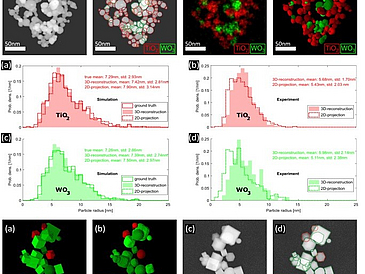Christoph Mahr, Jakob Stahl, Beeke Gerken, Florian F. Krause, Marco Schowalter, Tim Grieb, Lutz Mädler, Andreas Rosenauer
Ultramicroscopy 265 (2024): 114020
https://doi.org/10.1016/j.ultramic.2024.114020
Structural and chemical characterization of nanomaterials provides important information for understanding their functional properties. Nanomaterials with characteristic structure sizes in the nanometer range can be characterized by scanning transmission electron microscopy (STEM). In conventional STEM, two-dimensional (2D) projection images of the samples are acquired, information about the third dimension is lost. This drawback can be overcome by STEM tomography, where the three-dimensional (3D) structure is reconstructed from a series of projection images acquired using various projection directions. However, 3D measurements are expensive with respect to acquisition and evaluation time. Furthermore, the method is hardly applicable to beam-sensitive materials, i.e. samples that degrade under the electron beam. For this reason, it is desirable to know whether sufficient information on structural and chemical information can be extracted from 2D-projection measurements. In the present work, a comparison between 3D-reconstruction and 2D-projection characterization of structure and mixing in nanoparticle hetero-aggregates is provided. To this end, convolutional neural networks are trained in 2D and 3D to extract particle positions and material types from the simulated or experimental measurement. Results are used to evaluate structure, particle size distributions, hetero-aggregate compositions and mixing of particles quantitatively and to find an answer to the question, whether an expensive 3D characterization is required for this material system for future characterizations.

